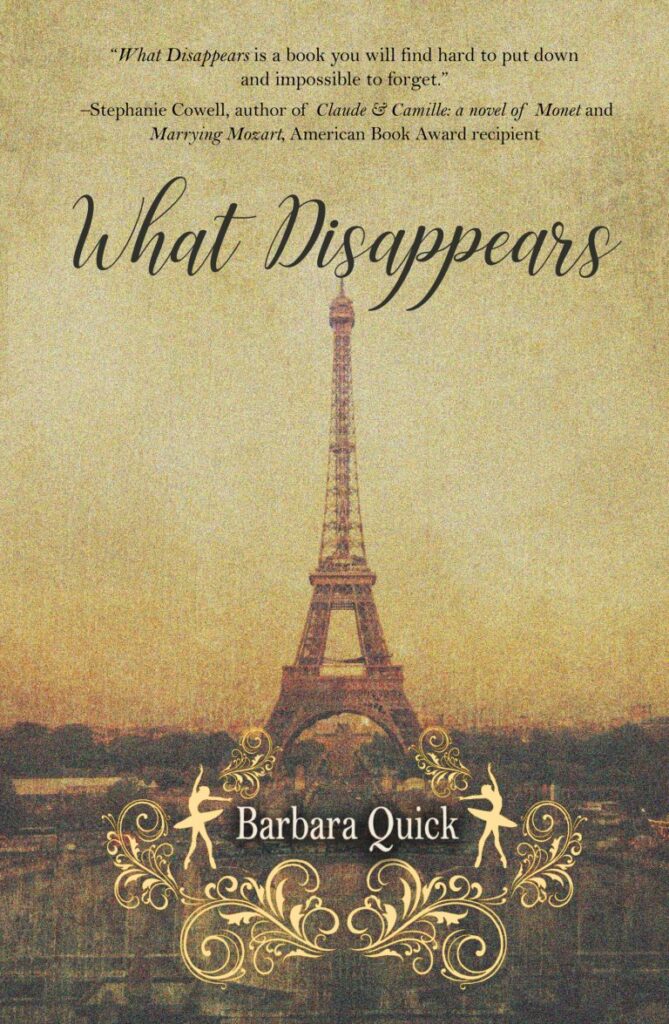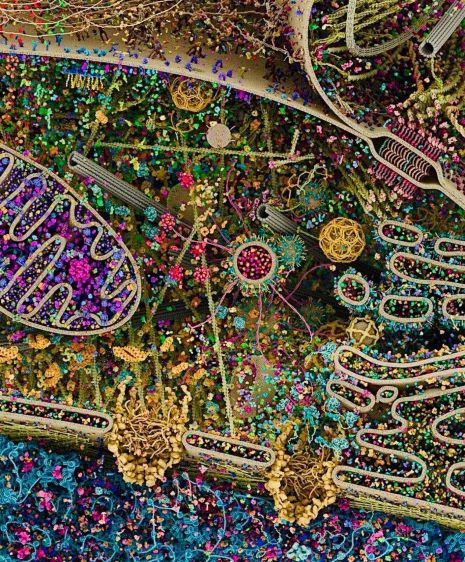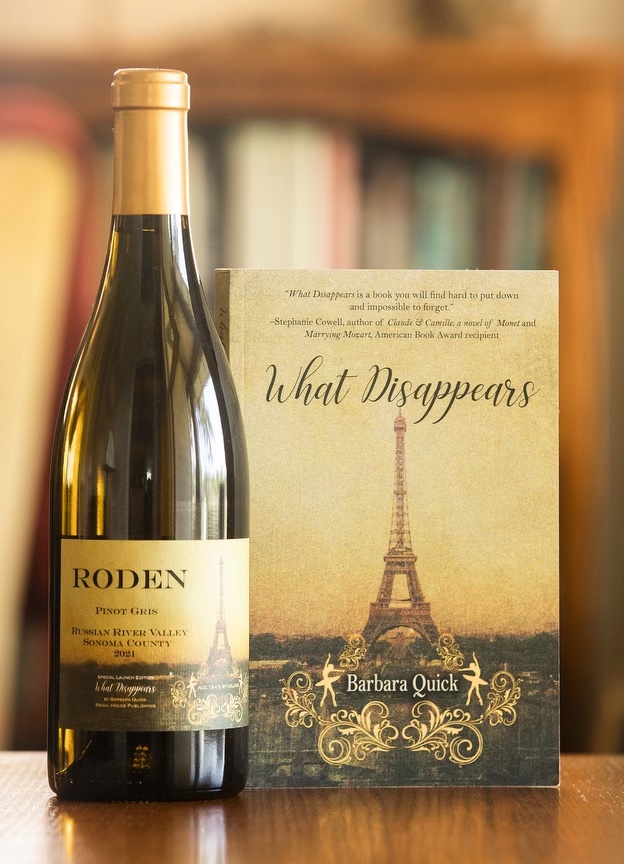Editor’s Note: This exchange is part of a series of brief interviews with emerging writers of recent or forthcoming books. If you enjoyed it, please visit other interviews in the I’ve Got Questions feature.
- What’s the title of your book? Fiction? Nonfiction? Poetry? Who is the publisher and what’s the publication date?
The title of my novel is What Disappears. It’s being published on May 17, 2022, by Regal House Publishing.
- In a couple of sentences, what’s the book about?
What Disappears is a multi-generational tale that begins in Tsarist Russia in the late 19th century and ends in Paris with the start of the First World War. One of two identical twins born to a Jewish family in dire political and financial straits, Zaneta is spirited out of an orphanage by a Catholic family from France. The other twin, Sonya—raised to believe her sister died at birth—has her life upended by the 1903 pogrom in Kishinev. They come face to face as 29-year-old identical strangers in the doorway of Anna Pavlova’s dressing-room when both get jobs in Paris with Sergei Diaghilev’s Ballets Russes. The resulting complicated relationship affects not only their lives but also the lives and fates of Sonya’s three daughters. Peopled by the greatest dancers, writers, artists, designers, and trendsetters of the Belle Époque, What Disappears explores the ways in which girls and women define their identity and search for meaning in a world that tries at every turn to hold them back.
- What’s the book’s genre (for fiction and nonfiction) or primary style (for poetry)?
This is not a genre novel, as such. None of my novels are. Because the story takes place in the past—and my fictional characters’ lives are interwoven with the lives of people who really lived—the book is, strictly speaking, historical fiction. But it aspires to be literary fiction—a novel replete with the emotional truth and nuanced complexity of—dare I say it?—literature. It both amused and saddened me, about a decade ago, to see that “literary fiction” is now categorized as a genre, in some bookstores, at least, right alongside Westerns and romance novels.
- What’s the nicest thing anyone has said about the book so far?
When the wonderful ballet memoirist Gavin Larsen read my novel in manuscript—and provided my publisher with a gorgeous jacket quote—I honestly felt, well, I can die now. Is it okay to quote her extensively here?
“With a dancer’s grace, agility and subtlety, Barbara Quick creates indelible scenes that unfold as her characters, both famous and fictional, discover the fragility of their deepest core values. I couldn’t turn the pages fast enough to keep up with my own racing mind! How do we use the artistic self to cover or costume or hide? In this author’s hands, twin-hood becomes a metaphor for the conflict between a stage persona and an offstage one. I shivered with recognition at her portrayal of the male ego, presumption, oblivion and rational thought being clouded by carnal or artistic desires. Any dancer or athlete will resonate with these characters’ use of physical work to staunch or avoid the excruciating reality of emotional pain. The historic figures in the book—Diaghilev, Nijinsky, Pavlova, Karsavina, and titans of the fashion world—become ever more real through the way Quick illustrates the turmoil and self-doubt of the artistic mind, regardless of the artist’s fame. Quick reveals symbolism threaded through these characters’ lives that sheds light on our own in the way only great literature can do. Are we all performing our way through life, “running from whatever demons we carry around inside us… straight into the arms of death”? By the end of this masterful work, we can indeed understand that when our inner and outer selves reconcile, what disappears is in fact what remains.” ~Gavin Larsen, author of Being a Ballerina: The Power and Perfection of a Dancing Life
Part of why this quote means so much to me is that, despite the years and years of assiduous research I did for What Disappears—and despite the fact that I have some dance training—I have never been a ballerina or lived inside that singular world. Getting this kind of validation from a writer who has lived and breathed that world, and also written so beautifully about it, felt like a kind of benediction.
- What book or books is yours comparable to or a cross between? [Is your book like Moby Dick or maybe it’s more like Frankenstein meets Peter Pan?]
I’m a great admirer of the British novelist Rose Tremain—now Dame Rose Tremain—who is known as a historical novelist who approaches her subjects “from unexpected angles.” That’s what I’m trying to reveal in both my poetry and my fiction: the glorious complexity of what it means to be alive.
There’s a photograph that’s been going around social media, of NASA’s most up-to-date model of a human cell. One human cell—and it’s as intricate, gorgeous, and moving as a truly great work of art. Seeing this photo made me realize that art, at its best, is only an imitation of the beauty and complexity of the natural world.
That’s the novelist’s—and especially the poet’s—job, to pay attention. To look very closely. To reflect and scrutinize and empathize—and make connections that deliver those “Ah-ha!” moments of wisdom and relief. That change the way the reader looks at the world—and, at their best—crack the reader’s heart open. Making a reader laugh or cry is my greatest reward.
I recently came upon poet and novelist Mary Mackey’s 1986 New York Times bestselling novel, A Grand Passion, which also takes place in the world of ballet, although at a much later era than mine. It’s an amazing work of cultural and occupational ventriloquism. I think I like novels best that are written by poets—because poets walk many times around every word before giving it a place in their story. Margaret Atwood is also that kind of novelist.
And now I guess I’ve danced around your question, Cliff, instead of really answering it.
- Why this book? Why now?
Honestly, I think this novel chose its own birthdate. I started writing this story well over 40 years ago, when I was a 21-year-old poet ensconced in a borrowed cottage in rural West County Cork, Ireland. It was my first attempt at an extended piece of prose fiction. I called it “The Russian Winter.” It was based on stories I’d been able to wrest out of my taciturn maternal grandmother about her childhood as the daughter of a family of Jewish tailors in Kishinev, in Tsarist Russia. Her stories both intrigued and mystified me—especially the factoid that her mother, my great-grandmother, took the train twice a year to Paris to see the fashions.
The sketches in “The Russian Winter” unspooled smoothly enough—and a couple of scenes (such as Sonya’s kiss from Jascha, the pharmacist’s son, underneath a streetlamp in the snow) survived quite intact in the final version of my novel.
But it took me all these decades to find the complex, beautiful, and ultimately logical pathways that could explain those twice-a-year, unaffordable and daring trips to Paris taken by the character who took over from those stories about my great-grandmother.
I started working seriously on the novel again about 10 years ago, after three other novels of mine had been published and one of them, Vivaldi’s Virgins, had been translated into over a dozen languages—and I’d honed my craft to the point where I felt I might be able to do justice to this story, with its large cast of characters, set in an era of such great cultural importance: the Belle Époque in Paris. I wrote about the Russian flu pandemic of 1889 years before the flu pandemic of our present day. I wrote about the fight for women’s rights in France well before I knew that women’s rights in our country, in my lifetime, would once again be so obscenely under siege. And at the end of What Disappears, I wrote about the terrifying runup to the First World War. One of my characters, witnessing the patriotic mobilization in Paris, agonizes, “Why do all these people look so excited and happy? Don’t they see […] the months and perhaps even years of suffering that lie ahead, the young men who will murder and be murdered, the mutilated bodies, the grief that always follows in the wake of war?”
Why this book? Why now? Because this is exactly the time when this novel needed to be published. I can’t take credit for this. In all my ignorance, I would have felt perfectly happy if this novel, in whatever state it was in then, had been published sooner. I’m grateful that the novel made me wait!
- Other than writing this book, what’s the best job you’ve ever had?
Well, writing books has been my “job,” sometimes to my financial peril, since 1990, when my first novel, Northern Edge, was published and awarded the Discover: Great New Writers prize. (It took me a very long time after that to be, by anyone’s definition of the word, “discovered”!) It wasn’t an easy road—and I usually had some kind of editing job or journalism gig to help pay my rent and keep food on the table. My very favorite of these gigs was working as a writer and editor for a site called MyPrimeTime.com. Besides serving as a sort of eminence grise there—most everyone else at that bright-and-shiny dot-com was a Millennial—my bailiwick was to write a weekly column called “The Gender Dialogues.” They were sort of faux anthropological commentaries on the sources of human behavior, with a specific focus on the interactions between the sexes. Quite often when one of my columns was published, my colleagues greeted me at the office with a round of applause. (They also did that once when I showed up sporting a pair of tight leather pants.) They were a lovely, bright group of writers and programmers—and I’m still in touch with some of them today. I have a so-far unpublished book, one I’ve been keeping under wraps, called “Boardinghouse Reach: A Novel with Recipes,” which features most of those columns as the work of the (barely) fictional protagonist, a single mom running an international boardinghouse in the East Bay, trying to make ends meet.
- What do you want readers to take away from the book?
I’ve been very gratified to hear from a lot of early readers that they “couldn’t put the book down!” That’s what every novelist wants to hear, isn’t it? I want readers to come away from my novel—from all my novels—feeling as if they’ve been transported into another time and place and even into other people’s bodies, feeling without reservation the emotions of the characters, their struggles, their hopes, their small moments of victory. I want all my readers to have the pleasure, as I have had as a writer, of getting to be a time-traveler: of getting as close as anyone can get to actually experiencing what it’s like to be someone else. And I want them to find, as I have, resonance with their own hopes and dreams and struggles in the lives of the characters—both the fictional ones and the historical ones—who populate the pages of What Disappears.
- What food and/or music do you associate with the book?
I wrote a lot of my final draft of What Disappears while listening to Brahms’ Second Symphony. It has been my goal to write a novel that travels along a reader’s neural pathways with the swiftness and directness of music, straight to the heart. Music has always been an important part of my life, even though I’m not a musician. For the past 14 years, through my husband—who is a professional musician—I’ve had unusually close access to the San Francisco Symphony: he’s a member of the viola section, and I try to attend every program. Whenever Brahms’ Second Symphony is performed these days, I’m a soggy mess beneath my mask. I associate each of the instruments now with one of my characters. I know the piece ridiculously well. There’s a similarly vivid experience for me whenever I get to hear Stravinsky’s Rite of Spring. The so-called “Riot at the Rite” in 1913, when the ballet debuted in Paris, plays a pivotal role in my novel.
Food and cooking—and growing food—are big parts of my life. I find lots of my poems in the garden and the kitchen. Getting to hear Garrison Keillor reading my poem, “Conjuring Nana,” on The Writer’s Almanac last year, was one of the highlights of my career as a poet—really, the beginning of my “career” as a poet. Before last year, my poetry was only something I had done for my own emotional survival since the age of nine, and was very rarely a public thing. Now, all of a sudden, I find myself being a poet in the public eye.
My Nana’s chicken soup, not surprisingly, found its way into this novel—as well as my memories of the Russian borscht she made. There was always some delicious, salty condiment fermenting in her kitchen (and often around ours, too, after she’d spent time with us): dill pickles and sauerkraut, which don’t smell too great while they’re in progress but are so delicious by the time they make it to the table. My great-aunt Tillie’s rugelach—and the fog of powdered sugar in her kitchen while she made those supremely delicious, Old World cookies—also make an appearance in the scenes from Kishinev.
And the seduction scene in the Parisian bistro, when Paul Poiret is demonstrating the rituals of wine connoisseurship to Sonya, is modeled on the deep knowledge possessed by my husband, who is a vigneron as well as a violist. He has dedicated the 2021 vintage of our Pinot gris to my novel, with a special label designed to mirror the cover art. We’re going to pour it, where permitted, at all my upcoming in-person events.
- What book(s) are you reading currently?
I have so many writer friends whose books I’d like to mention here—too many! In the interest of fairness and honesty, I’m going to give you the titles of the actual books I have stacked up right now on my bedside table. It’s quite an eclectic collection! Deep Hanging Out: Wanderings and Wonderment in Native California by Malcolm Margolin. The Thrall’s Tale by Judith Lindbergh (whose next novel, “Pasture of Heaven,” is going to be published by Regal House). The latest collection of poems by the delightful George Bilgere: Central Air. My Current Name is Jackie Fromm, a privately published memoir by my late mother’s best friend, who just celebrated her 99th birthday. We Own the Forests by the poet Hans Børli (in a bi-lingual edition translated from the Norwegian by Louis A. Muinzer).
Learn more about Barbara on her website.
Follow her on Facebook and Twitter.
Buy the book from the publisher (Regal House Publishing) or on Bookshop.org.





Thank you so much for interviewing me, Cliff!